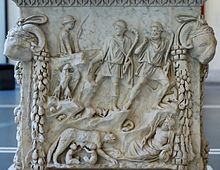Irene Iacopi
Irene Iacopi is an Italian archaeologist.

In January 2007, Iacopi announced that she had probably found the legendary cave of Lupercal beneath the remains of the House of Augustus, the Domus Livia, on the Palatine Hill,[1][2][3] believed by ancient Romans to be the cave, where the twin boys Romulus and Remus were suckled by a she-wolf. Andrea Carandini, a professor of archaeology specialising in ancient Rome, described it as "one of the most important discoveries of all time".[4]
These assertions have proved controversial. Adriano La Regina (formerly Rome's archaeological superintendent 1976–2004, professor of Etruscology at Sapienza University of Rome),[5] Professor Fausto Zevi (professor of Roman Archaeology at Rome's La Sapienza University)[6] and Professor Henner von Hesberg (head of the German Archaeological Institute, Rome)[7] denied the identification of the grotto with Lupercal on topographic and stylistic grounds. They concluded that the grotto is actually a nymphaeum or underground triclinium from Neronian times. The current scholarly consensus is that the grotto is not the Lupercal and that the cave was located lower southwest, closer to piazza Sant'Anastasia al Palatino.[8][9]
Selected publications
- L'Antiquarium forense (Itinerari dei musei, gallerie e monumenti d'Italia) Istituto Poligrafico dello Stato (1974)
- Gli scavi sul colle Palatino: Testimonianze e documenti Electa (1997) ISBN 978-8843563302
- La decorazione pittorica dell'aula isiaca Electa (1997) ISBN 978-8843563296
- Domus Aurea Electa (1999) ISBN 978-8843571741
- The House of Augustus: Wall Paintings Electa (2008) ISBN 978-8837064389
References
- ^ "The Battle for Rome's Treasures". Newsweek. 2007-12-12. Retrieved 2018-10-06.
- ^ "Audio News for November 18th to November 24th, 2007". www.archaeologychannel.org. Retrieved 2018-10-06.
- ^ Hooper, John (2007-11-21). "Rome uncovers its founding moment". the Guardian. Retrieved 2018-10-06.
- ^ Kiefer, Peter (2007-11-20). "Shedding light on the myth of Rome's birth". New York Times. Retrieved 2018-10-06.
- ^ Aloisi, Silvia. "Expert doubts Lupercale 'find'" Archived 24 November 2007 at the Wayback Machine, The Australian, 24 November 2007.
- ^ "È uno splendido ninfeo, ma il Lupercale non era lì", la Repubblica, 23 November 2007.
- ^ Schulz, Matthia. "Is Italy's Spectacular Find Authentic?" Spiegel Online, 29 November 2007.
- ^ Coarelli, Filippo (2012). Palatium. Rome: Quasar. pp. 132–9.
- .
